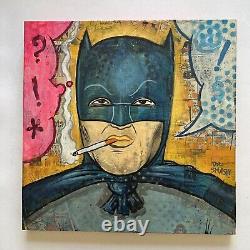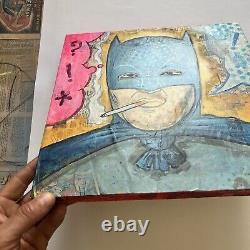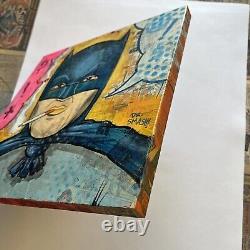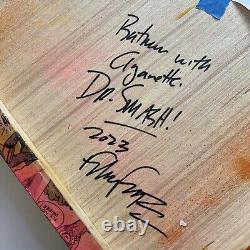
- Homepage
- Character
- Batman (51)
- Captain America (9)
- Catwoman (8)
- Conan (12)
- Deadpool (8)
- Doctor Strange (29)
- Firestorm (8)
- Green Lantern (11)
- Harley Quinn (17)
- Iron Man (14)
- Punisher (19)
- Siren (15)
- Spawn (16)
- Spider-man (46)
- Superman (30)
- Unknown (9)
- Vampirella (21)
- Venom (13)
- Wolverine (33)
- Wonder Woman (20)
- ... (2974)
- Illustrator
- Al Rio (13)
- Alex Sanchez (10)
- Calvin Henio (13)
- Dave Berg (8)
- Ed Benes (22)
- F Newton Burcham (14)
- George Perez (22)
- Howard Chaykin (7)
- Jim Lee (11)
- Jock (7)
- Joe Bennett (7)
- Keyeske (14)
- Mark Bagley (14)
- Michael Jasorka (7)
- Mike Grell (7)
- Neal Adams (22)
- Rodney Buchemi (12)
- Ryan Stegman (7)
- Tyler Kirkham (9)
- Unknown (8)
- ... (3129)
- Item Height
- Item Length
- Signed By
- Al Rio (9)
- Alex Sanchez (8)
- Burcham (13)
- Calvin Henio (13)
- Dave Berg (8)
- Jeff Taylor (16)
- John Biardo (6)
- John Romita Jr. (5)
- Kenyon Martin (6)
- Kevin Eastman (5)
- Keyeske (14)
- Matt Fraction (11)
- Mike Grell (5)
- Neal Adams (8)
- Nidhi Bandil Agarwal (18)
- No One (6)
- Rodney Buchemi (11)
- Svitlana Asafailo (5)
- Tone Rodriguez (26)
- Walt Simonson (5)
- ... (3165)
- Tradition
Batman With A Cigarette Dr. Smash Pop Surrealism Original Street Art Painting







Inspired by Batman'66 TV show of the 1960s featuring Adam West. This painting Pop-Art painting is done on 20"x28" wood and is the same proportions as a One Hundred Dollar Bill. This is an original painting by artist. Acrylic, spray paint, ink, comic book pages, vellum on wood. Smash is a contemporary Neo-Pop Artist.
Using iconic imagery from cartoons, comic books, film and advertising, he has been pushing the envelope of contemporary art. The orchestrated collision of street art and pop art has been his balancing act. Smash works in acrylics, spray paint, ink and assemblage. His paintings and drawings are a juxtaposition of inspiration from TV, comic books and pop culture with a fun and eclectic twist. Trying to capture the feeling and emotion of a moving cartoon on a flat canvas, or the mood one gets when flipping the pages of an old comic book, Dr.Smash's work incorporates fun, strange and recognizable subjects in disturbingly bizarre situations. Smash has a background in advertising, film and comics. His film and TV credits include: Lovecraft Country, Fantasy Island, Solar Opposites, Dreamwork's 3Below, Bob's Burgers, Insidious 4, Lego: Guardians of the Galaxy, Despicable Me 2, Lego Star Wars: The Empire Strikes Out, The Super Hero Squad Show, Marvel Heroes 4D, and Lego Hero Factory. Smash's comic book credits include: Heavy Metal Magazine, Bob's Burgers, Warlash, DTOX, Zombie Terrors and Chicken Soup For Satan among others.
Street art is visual art created in public locations for public visibility. It has been associated with the terms "independent art", "post-graffiti", "neo-graffiti" and guerrilla art.Street art has evolved from the early forms of defiant graffiti into a more commercial form of art, as one of the main differences now lies with the messaging. Street art is often meant to provoke thought rather than rejection among the general audience through making its purpose more evident than that of graffiti. The issue of permission has also come at the heart of street art, as graffiti is usually done illegally, whereas street art can nowadays be the product of an agreement or even sometimes a commission. However, it remains different from traditional art exposed in public spaces by its explicit use of said space in the conception phase. Lowbrow, or lowbrow art, describes an underground visual art movement that arose in the Los Angeles, California area in the late 1960s.
[1] It is a populist art movement with its cultural roots in underground comix, punk music, tiki culture, graffiti, and hot-rod cultures of the street. [2] It is also often known by the name pop surrealism. [3] Lowbrow art often has a sense of humor - sometimes the humor is gleeful, sometimes impish, and sometimes it is a sarcastic comment. Most lowbrow artworks are paintings, but there are also toys, digital art, and sculpture.
Some of the first artists to create what came to be known as lowbrow art were underground cartoonists like Robert Williams and Gary Panter. Early shows were in alternative galleries in New York and Los Angeles such as Psychedelic Solutions Gallery in Greenwich Village, New York City which was run by Jacaeber Kastor, [5] La Luz de Jesus run by Billy Shire[6] and 01 gallery in Hollywood, run by John Pochna. [5] The movement steadily grew from its beginning, with hundreds of artists adopting this style. As the number of artists grew, so did the number of galleries showing Lowbrow. In 1992 Greg Escalante helped orchestrate the first formal gallery exhibition to take low brow art seriously; painter Anthony Ausgang's solo show "Looney Virtues" at the Julie Rico Gallery in Santa Monica. The Bess Cutler Gallery also went on to show important artists and helped expand the kind of art that was classified as Lowbrow. The lowbrow magazine Juxtapoz, launched in 1994 by Robert Williams, Greg Escalante, and Eric Swenson, has been a mainstay of writing on lowbrow art and has helped shape and expand the movement.Writers have noted that there are now distinctions to be drawn between how lowbrow manifests itself in different regions and places. Some see a distinct U. "West coast" lowbrow style, which is more heavily influenced by tiki, underground comix and hot rod car-culture than elsewhere. As the lowbrow style has spread around the world, it has been intermingled with the tendencies in the visual arts of those places in which it has established itself. As lowbrow develops, there may be a branching (as there was with previous art movements) into different strands and even whole new art movements.
In an article in the February 2006 issue of his magazine Juxtapoz, Robert Williams took credit for originating the term lowbrow art. He stated that in 1979 Gilbert Shelton of the publisher Rip Off Press decided to produce a book featuring Willams' paintings. Williams said he decided to give the book the self-deprecating title The Lowbrow Art of Robt. Williams, since no authorized art institution would recognize his type of art.
"Lowbrow" was thus used by Williams in opposition to highbrow. He said the name then stuck, even though he feels it is inappropriate. Williams refers to the movement as cartoon-tainted abstract surrealism. "[8] Lately, Williams has begun referring to his own work as "Conceptual Realism. Highly polished imagery inspired by cartoon characters and scenery - that is how one could describe.
But the truth is that this unconventional movement is much more than that. Are we even entitled to calling it a movement? Many acclaimed critics and respectable institutions, put in charge to decide what gets to be accepted as art and what does not fit in the mainstream demand of museums, galleries and even collectors, would put Lowbrow in the latter category without thinking twice.
But like many movements before it, Lowbrow art. Does not care about being recognized by the art world as legitimate.
If anything, Lowbrow artists wrote their own rules in an unapologetic way, rules that were clear enough to make this whole creative field stand on its own without a single problem. Because of its roots in the underground culture, Lowbrow / Pop Surrealism became a populist matter, inspired by such vast variety of topics and aesthetics that it made itself easily relatable to a large number of artists and admirers. So what exactly is it that makes Lowbrow art so distinct and alluring? The Advent of Lowbrow Art. Born in the shady corners of Los Angeles in the late 1970s, Lowbrow originated in the artworks of underground cartoonists that were put on display in alternative galleries in New York and California.Because of their particular artistic approach, they weren't perceived as "highbrow" or intellectual art - mainly because they were based on the rawness of. The rebellion of punk music, the hot rod and surf culture of the West Coast and, of course, stylized cartoons and comics.
In fact, it would seem as though Its Highness the art world was not particularly fond of this Lowbrow kind of humor, one that can be found in. Or Acid house flyers, circus posters. Kustom Kulture, Japanese anime, second-rate horror movies. As a consequence, Lowbrow art and its self-taught practitioners joined the club of the "outlaws" like illustrators. And enjoyed its own status of an academically neglected movement which nevertheless thrived in a self-made environment.
As such, Lowbrow art also managed to find home in many places around the globe and reflect their visual tendencies, thus evolving into many different branches and individual aesthetics. Although it did not have an official name until the beginning of the 1990s, Lowbrow art was already somewhat present in. During the 1960s too, as its traces could be found in the works of underground comix cartoonists like R. Clay Wilson, Victor Moscoso and Robert Williams. Ever since its earliest days, Lowbrow was dedicated to poking fun at the conventional matters of any kind, using humor and sarcasm as its strongest tools. Persistent in vision, Lowbrow created its own subversive culture filled with. Abstract imagery and dreamy cartoon characters. Painted and drawn with impressive technical ability - one that surely did not deserve to be ignored. The accomplishments of Lowbrow / Pop Surrealism creatives was firmly recognized, however, by. Founded in 1994 by the aforementioned. A pioneer and the biggest figure of the movement, he claims to have coined the term "lowbrow" and there is nobody to dispute that, as the support that his magazine has given to the artists and the production at large is still immense and important. Juxtapoz magazine gave these artworks visibility, popularity and a background in writing that was somewhat critical, and it freed this form of art from under the "dictatorship" of the New York scene and its predisposed rules of what art should mean and look like. Following the rise of Juxtapoz Magazine, as well as another seminal publication called. A number of individuals within the Lowbrow art movement began breaking away from the raw, gritty representation of cartoons and. Putting their classical artistic training to use, they started creating their artwork with more sophistication; the goal was to produce. While at the same time not abandoning the core of Lowbrow - its underground references.Despite their master painter techniques, these creatives did not reach the realms of the "snobbish" Highbrow - nor was this their intention - but they nevertheless managed to blur the line between low and high art, giving way to a new subclass of pieces that could be defined as. The invention of the term was attributed to. Who used it to describe his own paintings, an unlikely, yet rather successful mix of Pop art and.

